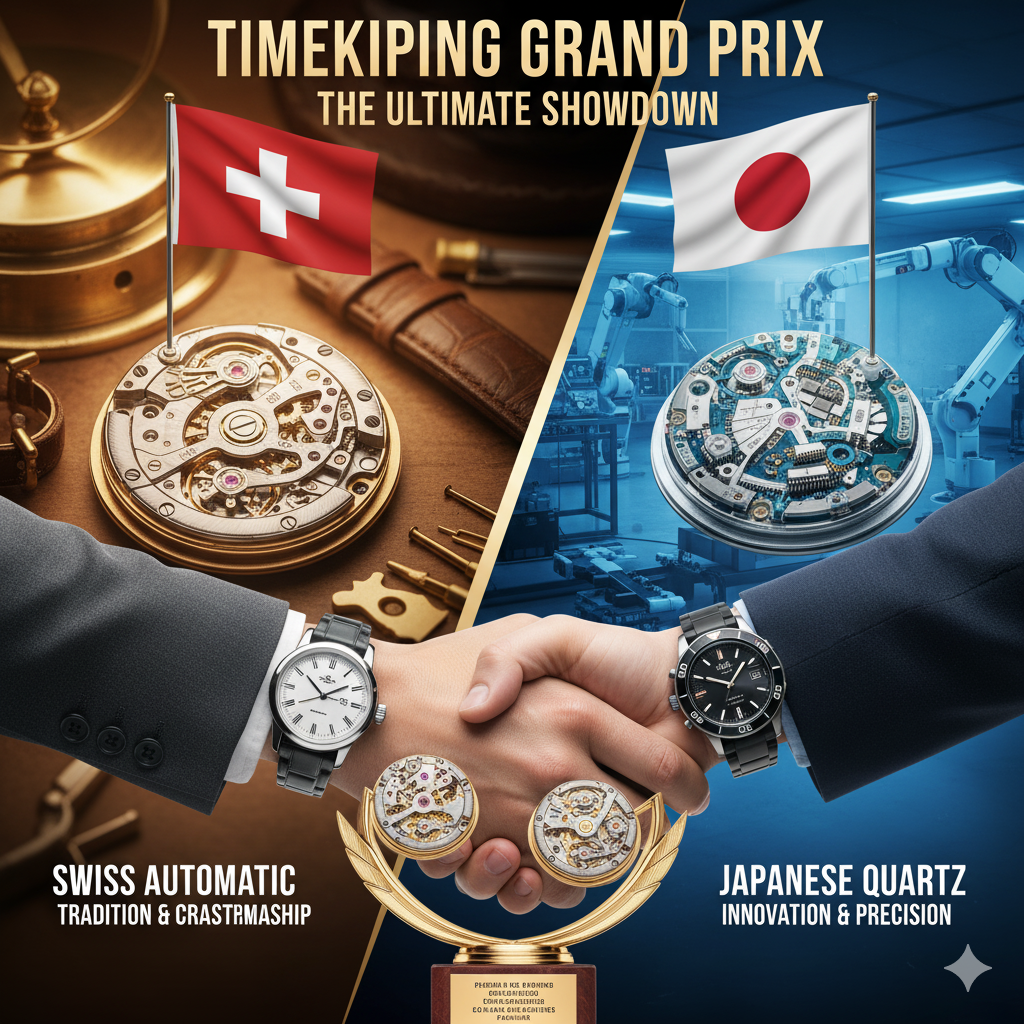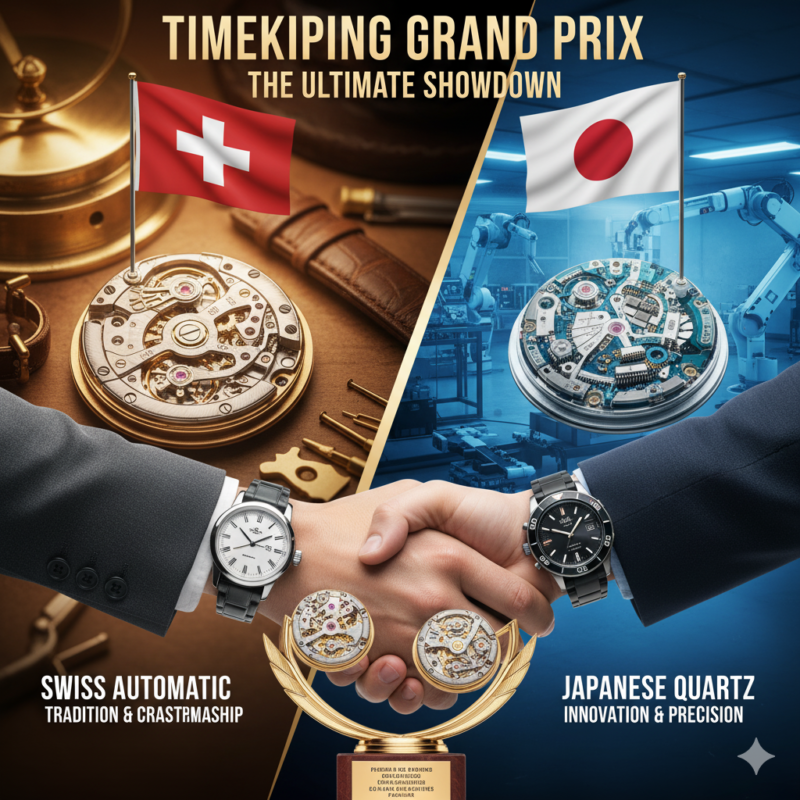The Great Watch Debate: Swiss Soul vs. Japanese Precision

In the world of horology, few rivalries are as defining, passionate, and misunderstood as the battle between the Swiss automatic mechanical watch and the Japanese quartz watch. This isn’t merely a choice between two types of timekeeping; it’s a clash of philosophies, heritage, and technology. It’s a story of a near-death experience for an industry, a revolution from the East, and an eventual peaceful coexistence where both sides emerged stronger.
To understand the competition, one must first understand the fundamental difference.
The Heart of the Matter: Mechanics vs. Electronics
A Swiss automatic watch is a marvel of micro-engineering. Its heart is a intricate symphony of hundreds of tiny parts—gears, springs, and levers—all working in perfect harmony. It is powered by the kinetic energy from the wearer’s wrist movement, which winds the mainspring. Its soul is its “tick”—a smooth, sweeping motion of the second hand, a testament to the mechanical poetry inside. Brands like Rolex, Patek Philippe, and Omega represent the pinnacle of this craft, often involving centuries of tradition, hand-finishing, and a value proposition rooted in artistry, heritage, and longevity.
A Japanese quartz watch, pioneered by Seiko with the Astron in 1969, is a product of modern science. Its heartbeat is a tiny battery sending an electrical current through a quartz crystal, causing it to vibrate at an incredibly precise frequency (32,768 times per second). These vibrations are counted by a circuit and converted into one pulse per second. This results in a distinctive “tick-tick” motion of the second hand. The value proposition is undeniable: incredible accuracy, affordability, and minimal maintenance. Brands like Seiko, Citizen, and Casio are the titans of this domain.
The Quartz Revolution: The Crisis That Reshaped an Industry
The late 1960s and 1970s marked the peak of this competition, known as the “Quartz Crisis” (or “Quartz Revolution” from the Japanese perspective). Swiss watchmakers, steeped in tradition, initially dismissed quartz as a passing fad. They were catastrophically wrong.
Japanese quartz watches were not only far more accurate than their mechanical counterparts but also cheaper to produce. The market was flooded with affordable, reliable timepieces that didn’t need winding. The Swiss industry, unprepared for this seismic shift, was decimated. Thousands of watchmakers lost their jobs, and iconic brands vanished forever.
The Swiss response was not to try and beat quartz at its own game on price, but to reinvent the value of the mechanical watch.

The Renaissance: Coexistence in a Two-Tier Market
From the ashes of the crisis, the Swiss industry staged a remarkable comeback. They realized their strength was never in pure utility, but in art, emotion, and luxury.
- The Rise of the Luxury Object: Swiss brands like Swatch Group (founded as a direct response to the crisis) brilliantly captured the low-end market with fun, affordable Swiss quartz watches. Meanwhile, high-end manufacturers doubled down on their heritage. They repositioned the mechanical watch not as a tool for telling time, but as a piece of wearable art, a status symbol, and an heirloom. The story, the craftsmanship, and the prestige became the product.
- Japanese Refinement: Japan didn’t stand still. Brands like Grand Seiko and Citizen elevated quartz technology to new heights. They developed “High-Accuracy Quartz” (HAQ) movements, thermocompensation, and solar-powered Eco-Drive technology, creating quartz watches that are breathtakingly precise, technologically advanced, and beautifully finished, competing directly with mid-tier Swiss luxury.
So, Which is Right for You? The Modern Choice
Today, the “competition” is less a war and more a division of the kingdom. The choice now depends entirely on what you value in a watch.
Choose a Swiss Automatic if you value:
- Craftsmanship & Heritage: You appreciate the history and the art of a hand-assembled movement.
- Emotional Connection: The idea of a machine powered by your own motion, with a soul and a story, resonates with you.
- Long-Term Value & Heirlooms: You see it as an investment piece to be passed down through generations.
- Status & Luxury: The brand prestige and recognition are important factors.
Choose a Japanese Quartz if you value:
- Precision & Reliability: You need a watch that tells near-perfect time with minimal fuss.
- Durability & Low Maintenance: You want a watch you can wear daily without worrying about winding, with years of battery life.
- Advanced Technology: Features like solar charging, atomic timekeeping, and multifunction capabilities appeal to you.
- Affordability & Value: You seek the best performance for your money.
The Verdict
The competition between Swiss automatic and Japanese quartz watches was a brutal but necessary event that forever changed watchmaking. It forced the Swiss to evolve and innovate, ultimately strengthening their position at the apex of luxury. It allowed the Japanese to establish a legacy of precision, reliability, and technological brilliance that dominates the global market.
In the end, there is no “winner.” There is only the right watch for the right person. On one wrist, a timeless piece of mechanical art, a connection to centuries of tradition. On the other, a triumph of modern science, a flawless tool for modern life. The true enthusiast understands and appreciates the genius of both.
